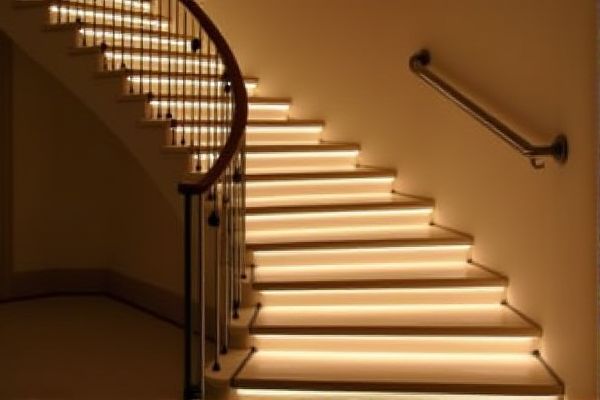
Handrail lighting provides subtle guiding illumination along staircases, enhancing safety without overwhelming brightness, while tread lighting focuses directly on individual steps to prevent trips by clearly outlining each tread. Discover the best lighting solution for your stairs by exploring the detailed comparisons in the rest of this article.
Table of Comparison
| Feature | Handrail Lighting | Tread Lighting |
|---|---|---|
| Location | Installed along the handrail of stairs | Mounted directly on stair treads or under the nosing |
| Primary Function | Illuminates the handrail for safety and guidance | Lights up the stair steps to enhance visibility |
| Safety | Provides directional guidance; reduces falls indirectly | Directly improves step visibility; minimizes trip hazards |
| Installation Complexity | Moderate; integrates with handrail structure | Varies; often requires wiring on each tread |
| Aesthetic Impact | Subtle accent lighting; highlights architectural details | More pronounced illumination; defines step edges clearly |
| Maintenance | Easy access; fewer units to service | Potentially higher; multiple lights to maintain |
| Energy Efficiency | Typically lower energy use due to fewer fixtures | Higher energy use depending on number of steps |
| Cost | Generally lower installation and material cost | Higher cost due to number of fixtures and wiring |
Introduction to Staircase Lighting Solutions
Handrail lighting offers a sleek, continuous illumination along the staircase, enhancing both safety and aesthetic appeal by highlighting the handrails themselves. Tread lighting, positioned on each step, provides direct visibility on the stair surfaces to prevent missteps in low-light conditions. Incorporating the right staircase lighting solution can elevate your home's ambiance while ensuring secure navigation.
What is Handrail Lighting?
Handrail lighting involves the integration of LED strips or fixtures directly into or along the handrail to provide subtle illumination and enhance safety on stairways. It creates a continuous, soft glow that highlights the handrail's path, reducing trip hazards in low-light conditions while adding an aesthetic appeal. When choosing handrail lighting, you ensure consistent guidance and a modern design touch alongside practical functionality.
What is Tread Lighting?
Tread lighting refers to the installation of LED or low-voltage lights directly into the horizontal surfaces of stair steps, enhancing visibility and safety in dark environments. Unlike handrail lighting, which illuminates the staircase from the side or above, tread lighting casts light on each step, reducing the risk of missteps and falls. This type of lighting is especially beneficial in both residential and commercial spaces where discreet, functional illumination is essential.
Comparative Aesthetics: Handrail vs Tread Lighting
Handrail lighting offers sleek, linear illumination that highlights the staircase's contours, creating a modern and minimalist aesthetic ideal for contemporary interiors. In contrast, tread lighting focuses light downward onto each step, enhancing safety while adding subtle depth and texture to the stairs' surface. Both options improve visibility, but handrail lighting provides a more prominent design feature, whereas tread lighting emphasizes functional elegance.
Safety Benefits: Which Offers Better Visibility?
Handrail lighting provides continuous illumination along stairways, enhancing visibility and reducing shadows that can obscure steps, which significantly improves overall safety. Tread lighting targets each stair individually, making step edges more distinct and reducing the risk of missteps, especially in low-light conditions. Between the two, handrail lighting generally offers broader, more consistent visibility, while tread lighting excels in highlighting specific hazards on each step.
Installation Complexity and Cost Analysis
Handrail lighting typically involves simpler installation processes, as it requires mounting LED strips or fixtures along the railing, often with less wiring complexity, resulting in lower labor costs compared to tread lighting. Tread lighting demands precise placement within stair treads or risers, necessitating more extensive wiring, cutting, and careful waterproofing, which increases installation time and expenses. Your choice should consider budget constraints and the desired aesthetic impact, as handrail lighting offers cost-effectiveness while tread lighting provides enhanced visual guidance and safety.
Energy Efficiency and Maintenance Needs
Handrail lighting typically uses low-wattage LED strips that consume less energy and require minimal maintenance due to sealed housing protecting against dust and moisture. Tread lighting, often embedded under stair nosings, may use higher power LEDs to ensure visibility, resulting in slightly increased energy consumption and more frequent maintenance to address dirt accumulation and mechanical wear. Choosing handrail lighting enhances energy efficiency and reduces upkeep costs, whereas tread lighting offers targeted illumination with higher maintenance demands.
Customization Options for Modern Interiors
Handrail lighting offers sleek customization options that integrate LED strips and adjustable brightness controls, perfect for modern interiors requiring subtle illumination along stairways. Tread lighting provides versatile designs with embedded step lights or minimalist recessed fixtures, enhancing safety while complementing contemporary decor. Both lighting styles support smart home integration and color temperature adjustments to match diverse aesthetic preferences.
Best Use Cases for Handrail and Tread Lighting
Handrail lighting excels in guiding pathways and enhancing safety in staircases, especially in dimly lit or high-traffic areas, where visibility along the handrail is crucial. Tread lighting is ideal for illuminating each step directly, offering heightened safety in stairs with uneven or varying heights, making it a preferred choice for outdoor stairs or spaces where tread visibility prevents tripping hazards. Combining both handrail and tread lighting creates a comprehensive safety system for both commercial and residential staircases, optimizing visibility and aesthetic appeal.
Conclusion: Choosing the Right Solution for Your Space
Handrail lighting offers effective guidance and safety by illuminating pathways at eye level, ideal for corridors and staircases with limited space. Tread lighting enhances visibility on stair steps themselves, reducing trip hazards and adding a modern aesthetic to staircases with open risers or wider steps. Selecting between handrail and tread lighting depends on your specific spatial requirements, safety priorities, and design preferences to create a functional and visually appealing environment.
 homyna.com
homyna.com